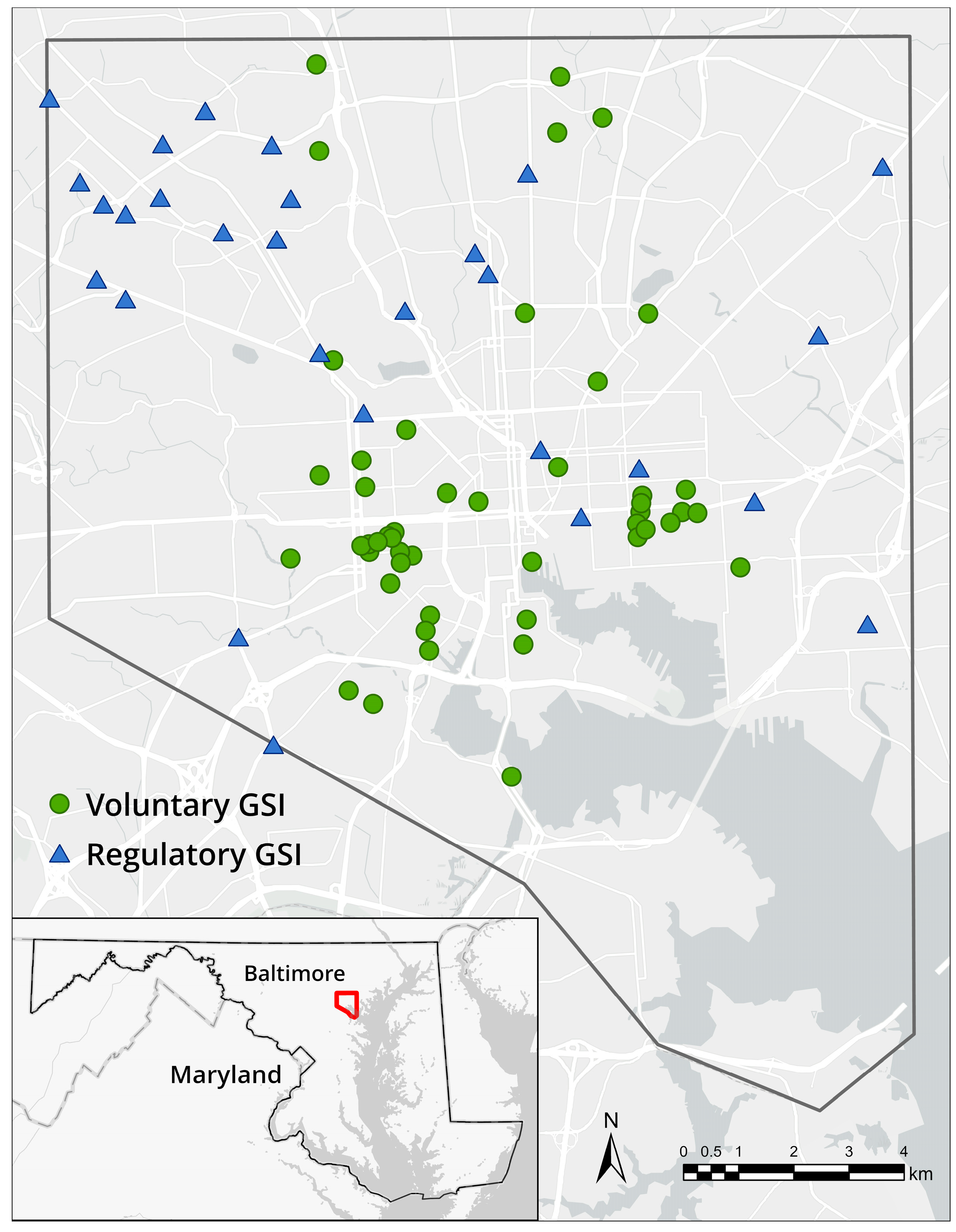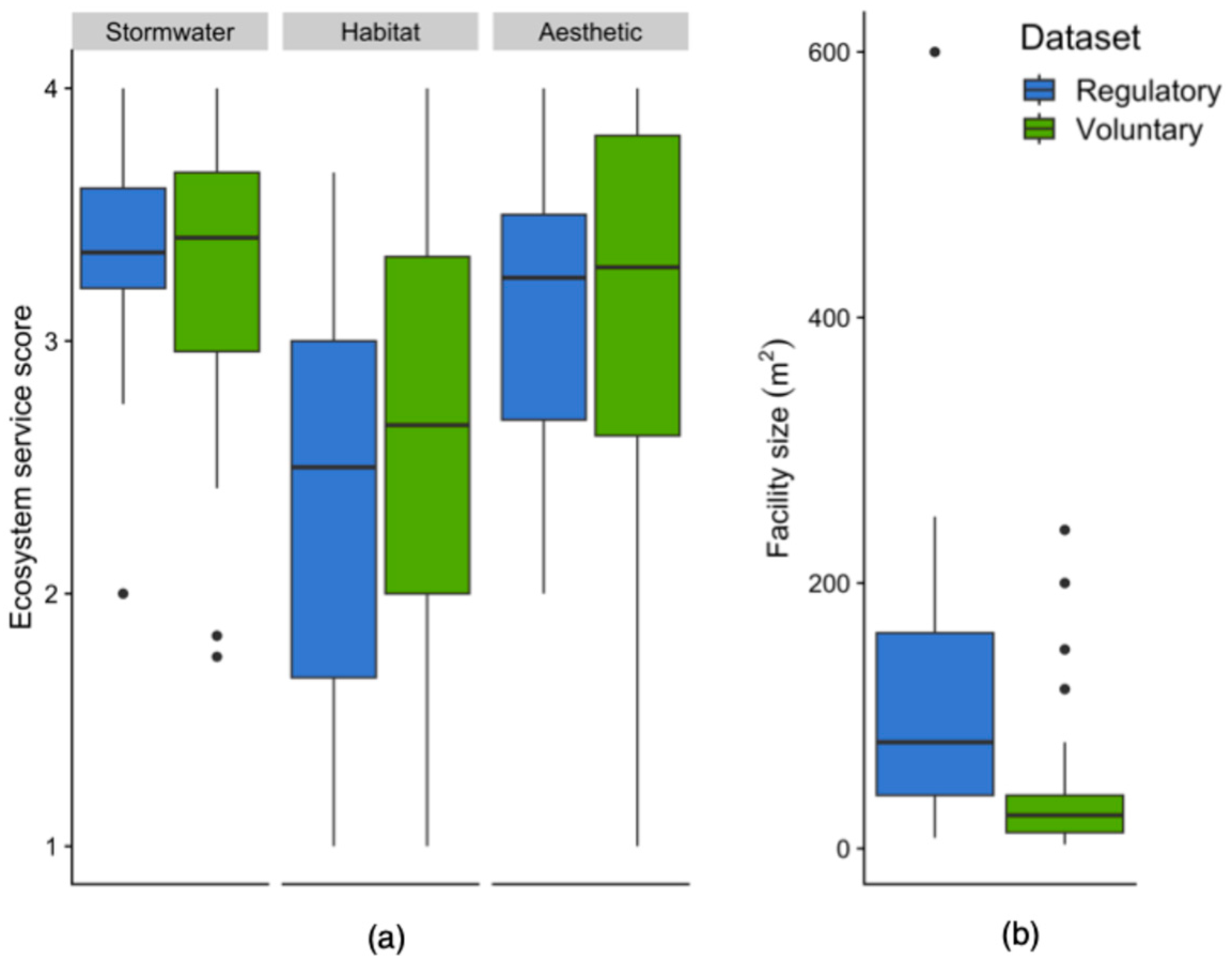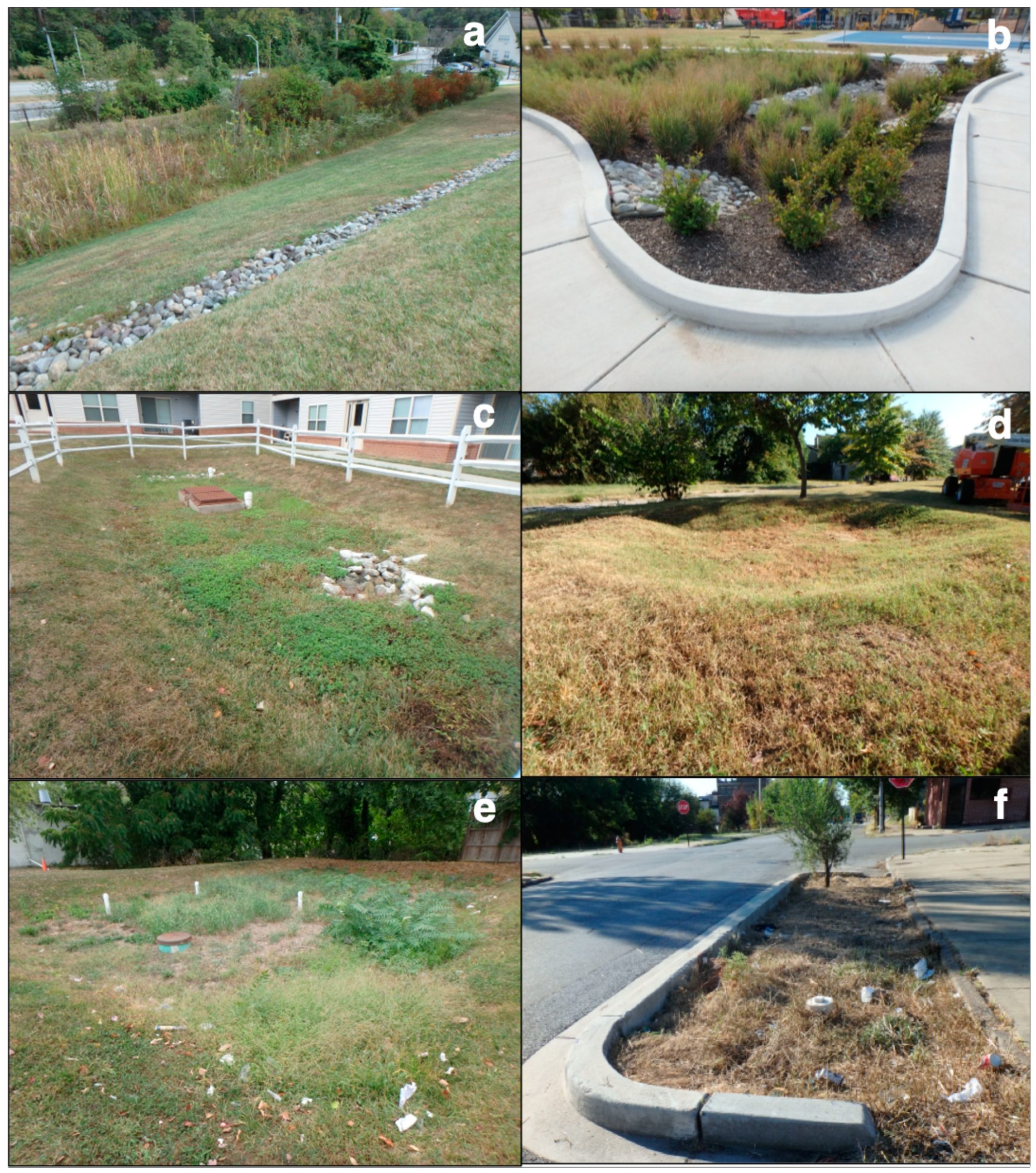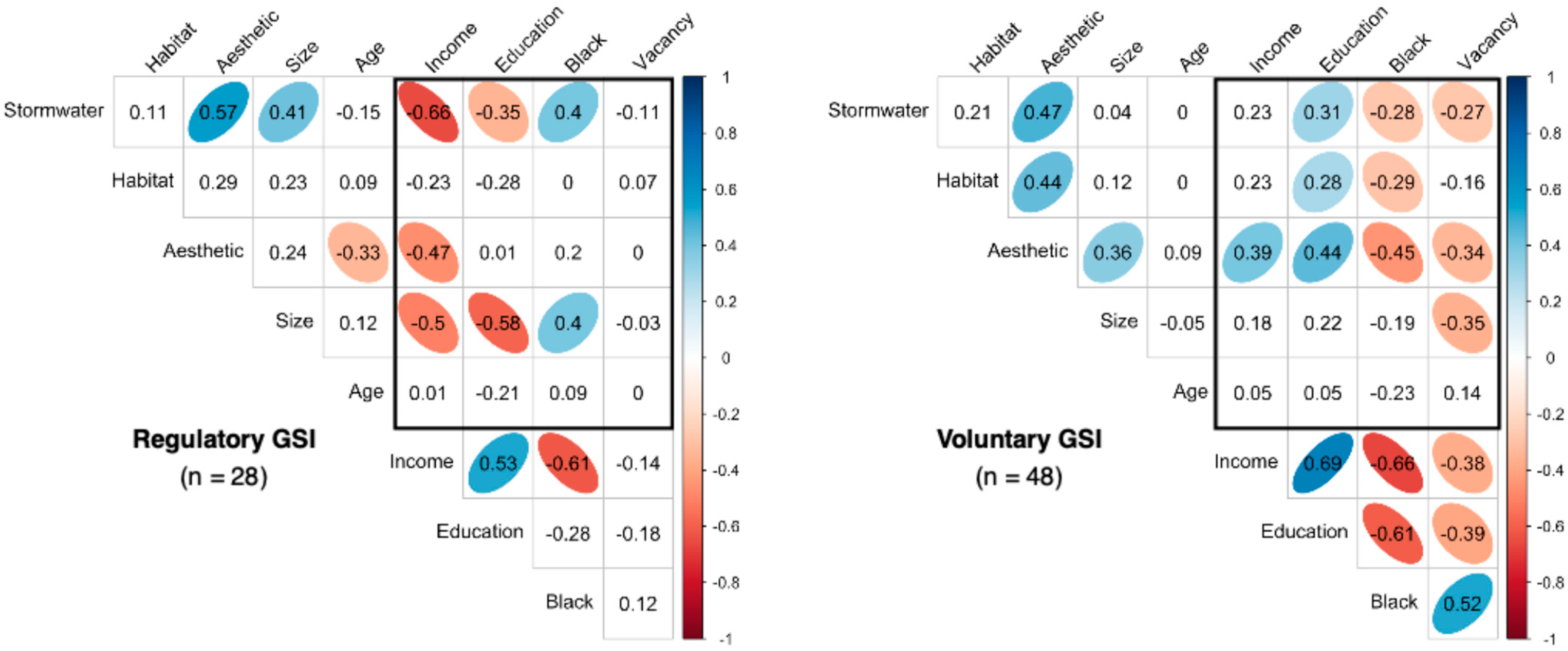Not Always an Amenity: Green Stormwater Infrastructure Provides Highly Variable Ecosystem Services in Both Regulatory and Voluntary Contexts
Abstract
1. Introduction
2. Materials and Methods
2.1. Study Area and Background
2.2. Data
2.3. Statistical Analysis
3. Results
4. Discussion
4.1. Ecosystem Services Are Variable for Both Regulatory and Voluntary GSI
4.2. Ecosystem Service Scores Are Related to Sociodemographic Characteristics
4.3. Limitations and Opportunities for Future Research
5. Conclusions
Author Contributions
Funding
Institutional Review Board Statement
Informed Consent Statement
Data Availability Statement
Acknowledgments
Conflicts of Interest
Abbreviations
| GSI | Green stormwater infrastructure |
| US EPA | United States Environmental Protection Agency |
| NPDES | National Pollutant Discharge Elimination System |
| MS4 | Municipal Separate Storm Sewer System |
References
- Spahr, K.M.; Smith, J.M.; McCray, J.E.; Hogue, T.S. Reading the Green Landscape: Public Attitudes toward Green Stormwater Infrastructure and the Perceived Nonmonetary Value of Its Co-Benefits in Three US Cities. J. Sustain. Water Built Environ. 2021, 7, 04021017. [Google Scholar] [CrossRef]
- Bell, C.D.; Spahr, K.; Grubert, E.; Stokes-Draut, J.; Gallo, E.; McCray, J.E.; Hogue, T.S. Decision Making on the Gray-Green Stormwater Infrastructure Continuum. J. Sustain. Water Built Environ. 2019, 5, 04018016. [Google Scholar] [CrossRef]
- Wang, M.; Sun, C.; Zhang, D. Opportunities and Challenges in Green Stormwater Infrastructure (GSI): A Comprehensive and Bibliometric Review of Ecosystem Services from 2000 to 2021. Environ. Res. 2023, 236, 116701. [Google Scholar] [CrossRef] [PubMed]
- Taguchi, V.J.; Weiss, P.T.; Gulliver, J.S.; Klein, M.R.; Hozalski, R.M.; Baker, L.A.; Finlay, J.C.; Keeler, B.L.; Nieber, J.L. It Is Not Easy Being Green: Recognizing Unintended Consequences of Green Stormwater Infrastructure. Water 2020, 12, 522. [Google Scholar] [CrossRef]
- DelGrosso, Z.L.; Hodges, C.C.; Dymond, R.L. Identifying Key Factors for Implementation and Maintenance of Green Stormwater Infrastructure. J. Sustain. Water Built Environ. 2019, 5, 05019002. [Google Scholar] [CrossRef]
- McPhillips, L.E.; Matsler, A.M. Temporal Evolution of Green Stormwater Infrastructure Strategies in Three US Cities. Front. Built Environ. 2018, 4, 26. [Google Scholar] [CrossRef]
- Hoover, F.A.; Meerow, S.; Coleman, E.; Grabowski, Z.; McPhearson, T. Why Go Green? Comparing Rationales and Planning Criteria for Green Infrastructure in U.S. City Plans. Landsc. Urban Plan. 2023, 237, 104781. [Google Scholar] [CrossRef]
- Erickson, A.J.; Gulliver, J.S.; Kang, J.-H.; Weiss, P.T.; Wilson, C.B. Maintenance for Stormwater Treatment Practices. J. Contemp. Water Res. Educ. 2010, 146, 75–82. [Google Scholar] [CrossRef]
- US EPA. Compendium of MS4 Permitting Aproaches Part 6: Green Infrastructure; US EPA: Washington, DC, USA, 2022; p. 65.
- Houle, J.J.; Roseen, R.M.; Ballestero, T.P.; Puls, T.A.; Sherrard, J. Comparison of Maintenance Cost, Labor Demands, and System Performance for LID and Conventional Stormwater Management. J. Environ. Eng. 2013, 139, 932–938. [Google Scholar] [CrossRef]
- Blecken, G.-T.; Hunt III, W.F.; Al-Rubaei, A.M.; Viklander, M.; Lord, W.G. Stormwater Control Measure (SCM) Maintenance Considerations to Ensure Designed Functionality. Urban Water J. 2017, 14, 278–290. [Google Scholar] [CrossRef]
- Everett, G.; Lamond, J.E.; Morzillo, A.T.; Matsler, A.M.; Chan, F.K.S. Delivering Green Streets: An Exploration of Changing Perceptions and Behaviours over Time around Bioswales in Portland, Oregon. J. Flood Risk Manag. 2018, 11, S973–S985. [Google Scholar] [CrossRef]
- Klein, R. Stormwater Best Management Practices Greater Baltimore Survey 2016; Community & Environmental Defense Services: Owings Mills, MD, USA, 2016; p. 88. [Google Scholar]
- Barclay, N.; Klotz, L. Role of Community Participation for Green Stormwater Infrastructure Development. J. Environ. Manag. 2019, 251, 109620. [Google Scholar] [CrossRef] [PubMed]
- Mandarano, L.; Meenar, M. Equitable Distribution of Green Stormwater Infrastructure: A Capacity-Based Framework for Implementation in Disadvantaged Communities. Local Environ. 2017, 22, 1338–1357. [Google Scholar] [CrossRef]
- US EPA. Green Infrastructure Funding and Technical Assistance Opportunities. Available online: https://www.epa.gov/green-infrastructure/green-infrastructure-funding-and-technical-assistance-opportunities (accessed on 15 December 2024).
- Phillips de Lucas, A.K. Gifting a White Elephant, in the Form of Green Infrastructure. Nature of Cities 2020. Available online: https://www.thenatureofcities.com/2020/08/18/gifting-a-white-elephant-in-the-form-of-green-infrastructure/ (accessed on 9 February 2025).
- Comber, A.; Brunsdon, C.; Green, E. Using a GIS-Based Network Analysis to Determine Urban Greenspace Accessibility for Different Ethnic and Religious Groups. Landsc. Urban Plan. 2008, 86, 103–114. [Google Scholar] [CrossRef]
- Ferguson, M.; Roberts, H.E.; McEachan, R.R.C.; Dallimer, M. Contrasting Distributions of Urban Green Infrastructure across Social and Ethno-Racial Groups. Landsc. Urban Plan. 2018, 175, 136–148. [Google Scholar] [CrossRef]
- Kabisch, N.; Haase, D. Green Justice or Just Green? Provision of Urban Green Spaces in Berlin, Germany. Landsc. Urban Plan. 2014, 122, 129–139. [Google Scholar] [CrossRef]
- Wolch, J.; Wilson, J.P.; Fehrenbach, J. Parks and Park Funding in Los Angeles: An Equity-Mapping Analysis. Urban Geogr. 2005, 26, 4–35. [Google Scholar] [CrossRef]
- Wüstemann, H.; Kalisch, D.; Kolbe, J. Access to Urban Green Space and Environmental Inequalities in Germany. Landsc. Urban Plan. 2017, 164, 124–131. [Google Scholar] [CrossRef]
- Boone, C.G.; Buckley, G.L.; Grove, J.M.; Sister, C. Parks and People: An Environmental Justice Inquiry in Baltimore, Maryland. Ann. Assoc. Am. Geogr. 2009, 99, 767–787. [Google Scholar] [CrossRef]
- Lindsey, G.; Maraj, M.; Kuan, S. Access, Equity, and Urban Greenways: An Exploratory Investigation. Prof. Geogr. 2001, 53, 332–346. [Google Scholar] [CrossRef]
- Talen, E. The Social Equity of Urban Service Distribution: An Exploration of Park Access in Pueblo, Colorado, and Macon, Georgia. Urban Geogr. 1997, 18, 521–541. [Google Scholar] [CrossRef]
- Sister, C.; Wolch, J.; Wilson, J. Got Green? Addressing Environmental Justice in Park Provision. GeoJournal 2010, 75, 229–248. [Google Scholar] [CrossRef]
- Smoyer-Tomic, K.E.; Hewko, J.N.; Hodgson, M.J. Spatial Accessibility and Equity of Playgrounds in Edmonton, Canada. Can. Geogr./Le Géographe Can. 2004, 48, 287–302. [Google Scholar] [CrossRef]
- Weiss, C.C.; Purciel, M.; Bader, M.; Quinn, J.W.; Lovasi, G.; Neckerman, K.M.; Rundle, A.G. Reconsidering Access: Park Facilities and Neighborhood Disamenities in New York City. J. Urban Health 2011, 88, 297–310. [Google Scholar] [CrossRef] [PubMed]
- Wendel, H.E.W.; Downs, J.A.; Mihelcic, J.R. Assessing Equitable Access to Urban Green Space: The Role of Engineered Water Infrastructure. Environ. Sci. Technol. 2011, 45, 6728–6734. [Google Scholar] [CrossRef] [PubMed]
- Solins, J.P.; Phillips de Lucas, A.K.; Brissette, L.E.G.; Morgan Grove, J.; Pickett, S.T.A.; Cadenasso, M.L. Regulatory Requirements and Voluntary Interventions Create Contrasting Distributions of Green Stormwater Infrastructure in Baltimore, Maryland. Landsc. Urban Plan. 2023, 229, 104607. [Google Scholar] [CrossRef]
- Bedimo-Rung, A.; Gustat, J.; Tompkins, B.; Rice, J.; Thomson, J. Development of a Direct Observation Instrument to Measure Environmental Characteristics of Parks for Physical Activity. J. Phys. Act. Health 2005, 3 (Suppl. S1), S176–S189. [Google Scholar] [CrossRef]
- Gidlow, C.J.; Ellis, N.J.; Bostock, S. Development of the Neighbourhood Green Space Tool (NGST). Landsc. Urban Plan. 2012, 106, 347–358. [Google Scholar] [CrossRef]
- Saelens, B.E.; Frank, L.D.; Auffrey, C.; Whitaker, R.C.; Burdette, H.L.; Colabianchi, N. Measuring Physical Environments of Parks and Playgrounds: EAPRS Instrument Development and Inter-Rater Reliability. J. Phys. Act Health 2006, 3, S190–S207. [Google Scholar] [CrossRef]
- van Dillen, S.M.E.; de Vries, S.; Groenewegen, P.P.; Spreeuwenberg, P. Greenspace in Urban Neighbourhoods and Residents’ Health: Adding Quality to Quantity. J. Epidemiol. Community Health 2012, 66, e8. [Google Scholar] [CrossRef]
- Cohen, J.R. Abandoned Housing: Exploring Lessons from Baltimore. Hous. Policy Debate 2001, 12, 415–448. [Google Scholar] [CrossRef]
- Massey, D.S.; Tannen, J. A Research Note on Trends in Black Hypersegregation. Demography 2015, 52, 1025–1034. [Google Scholar] [CrossRef]
- Brown, L.T. The Black Butterfly: The Harmful Politics of Race and Space in America; Johns Hopkins University Press: Baltimore, MD, USA, 2021; ISBN 978-1-4214-3987-7. [Google Scholar]
- Holtan, M.T.; Dieterlen, S.L.; Sullivan, W.C. Social Life Under Cover: Tree Canopy and Social Capital in Baltimore, Maryland. Environ. Behav. 2015, 47, 502–525. [Google Scholar] [CrossRef]
- Schwarz, K.; Fragkias, M.; Boone, C.G.; Zhou, W.; McHale, M.; Grove, J.M.; O’Neil-Dunne, J.; McFadden, J.P.; Buckley, G.L.; Childers, D.; et al. Trees Grow on Money: Urban Tree Canopy Cover and Environmental Justice. PLoS ONE 2015, 10, e0122051. [Google Scholar] [CrossRef] [PubMed]
- Solins, J.P.; Phillips de Lucas, A.K.; Cadenasso, M.L.; Grove, J.M. Green Stormwater Infrastructure Projects Voluntarily Installed in Baltimore City Through 2019. Environmental Data Initiative. 2021. Available online: https://portal.edirepository.org/nis/mapbrowse?packageid=knb-lter-bes.5015.1 (accessed on 9 February 2025).
- Scott, T.; Lane, C.; Scheuler, T. Bioretention Illustrated: A Visual Guide for Constructing, Inspecting, Maintaining and Verifying the Bioretention Practice; Chesapeake Stormwater Network: Ellicott City, MD, USA, 2013; p. 95. [Google Scholar]
- Beninde, J.; Veith, M.; Hochkirch, A. Biodiversity in Cities Needs Space: A Meta-Analysis of Factors Determining Intra-Urban Biodiversity Variation. Ecol. Lett. 2015, 18, 581–592. [Google Scholar] [CrossRef]
- Hennig, E.I.; Ghazoul, J. Pollinating Animals in the Urban Environment. Urban Ecosyst 2012, 15, 149–166. [Google Scholar] [CrossRef]
- Wenzel, A.; Grass, I.; Belavadi, V.V.; Tscharntke, T. How Urbanization Is Driving Pollinator Diversity and Pollination—A Systematic Review. Biol. Conserv. 2020, 241, 108321. [Google Scholar] [CrossRef]
- Jordan, K.K.; Jones, S.C. Invertebrate Fauna Associated with Mulch in Urban Environments. In Proceedings of the 4th International Conference on Urban Pests, Charleston, SC, USA, 7–10 July 2002; Pocahontas Press: Blacksburg, VA, USA, 2002; pp. 87–94. [Google Scholar]
- Stagoll, K.; Manning, A.D.; Knight, E.; Fischer, J.; Lindenmayer, D.B. Using Bird–Habitat Relationships to Inform Urban Planning. Landsc. Urban Plan. 2010, 98, 13–25. [Google Scholar] [CrossRef]
- Altman, A.; Shennan, S.; Odling-Smee, J. Ornamental Plant Domestication by Aesthetics-Driven Human Cultural Niche Construction. Trends Plant Sci. 2022, 27, 124–138. [Google Scholar] [CrossRef]
- Grove, M.; Ogden, L.; Pickett, S.; Boone, C.; Buckley, G.; Locke, D.H.; Lord, C.; Hall, B. The Legacy Effect: Understanding How Segregation and Environmental Injustice Unfold over Time in Baltimore. Ann. Am. Assoc. Geogr. 2018, 108, 524–537. [Google Scholar] [CrossRef]
- R Core Team R. A Language and Environment for Statistical Computing 2024; R Foundation: Vienna, Austria, 2024. [Google Scholar]
- Wei, T.; Simko, V. R Package “Corrplot”: Visualization of a Correlation Matrix. 2024. Available online: https://cran.r-project.org/web/packages/corrplot/corrplot.pdf (accessed on 9 February 2025).
- Krause, N. (Department of Public Works, Baltimore, MD, USA); Solins, J.P. (University of California, Davis, CA, USA). Personal Communication, 2019.
- Tran, T.J.; Helmus, M.R.; Behm, J.E. Green Infrastructure Space and Traits (GIST) Model: Integrating Green Infrastructure Spatial Placement and Plant Traits to Maximize Multifunctionality. Urban For. Urban Green. 2020, 49, 126635. [Google Scholar] [CrossRef]
- Kuller, M.; Bach, P.M.; Ramirez-Lovering, D.; Deletic, A. What Drives the Location Choice for Water Sensitive Infrastructure in Melbourne, Australia? Landsc. Urban Plan. 2018, 175, 92–101. [Google Scholar] [CrossRef]
- Meerow, S.; Newell, J.P. Spatial Planning for Multifunctional Green Infrastructure: Growing Resilience in Detroit. Landsc. Urban Plan. 2017, 159, 62–75. [Google Scholar] [CrossRef]
- Lausen, E.D.; Backhaus, A.; Jensen, M.B.; Lausen, E.D. Urbanites’ Perception of Vegetation in Landscape-Based Stormwater Management Elements (LSM). Urban Ecosyst 2022, 25, 1577–1588. [Google Scholar] [CrossRef]




| Variable | Score = 4 | Score = 3 | Score = 2 | Score = 1 |
|---|---|---|---|---|
| Bed erosion | Bed is flat and even; no sign of erosion | Minor rill/sheet erosion (<15 cm) | Moderate gully erosion (15–30 cm) | Major gully erosion (>30 cm) |
| Inlet erosion (N/A if no inlet) | No evidence of erosion at the inlet | Minor gully erosion (<15 cm) | Moderate gully erosion (15–30 cm) | Major gully erosion (>30 cm) |
| Inlet obstruction | No obstruction to water entering the facility at the inlet; inlet free of sediment/debris | Minor amount of sediment/debris accumulation at the inlet (<2.5 cm) | Moderate amount of sediment/debris accumulation at the inlet (2.5–8 cm) | Major obstruction of the inlet is likely preventing water from entering the facility (>8 cm) |
| Outflow obstruction (N/A if no outflow) | Outflow device is free of sediment/debris | Minor amount of sediment/debris; nominal loss of capacity | Moderate amount of sediment/debris; substantial loss of capacity | Outflow device is completely clogged with sediment/debris |
| Trash | Facility is largely free from trash (<1% coverage) | Facility contains trash, but it is concentrated or not highly noticeable (1–5% coverage) | Facility contains noticeable amounts of trash (5–25% coverage) | Facility is dominated by trash (>25% coverage) |
| Damage to structural elements (N/A if none present) | Facility has no signs of damage | Facility shows signs of minor damage (e.g., cracks in cement, graffiti) | Facility shows moderate signs of damage (e.g., some broken structures or missing parts) | Facility is majorly damaged (e.g., structures broken beyond function) |
| Vegetation maintenance | Vegetation is well maintained; lack of weeds, overgrowth, or dieback | Vegetation is maintained, but appears some time has passed without attention | Few signs of upkeep; many weeds present, vegetation overgrown, etc. | No signs of upkeep; vegetation completely overgrown; mostly weeds |
| Tree & shrub cover | >50% | 25–50% | 5–24% | <5% |
| Cover of plants with showy flowers | >50% | 25–50% | 5–24% | <5% |
| Total vegetation cover | >125% | 100–125% | 50–99% | <50% |
| Shannon Index for cover types | >1.4 | 1.21–1.4 | 1–1.2 | <1 |
| Ecosystem Service | Mean of Scores for: | Additional Factors |
|---|---|---|
| Stormwater | Inlet erosion (if inlet present) Bed erosion Inlet obstruction (if inlet present) Outflow obstruction (if outflow present) Total vegetation cover Trash | Subtract 0.25 for presence of:
|
| Habitat | Total vegetation cover Cover of plants with showy flowers Shannon Index for cover types | |
| Aesthetics | Vegetation maintenance Cover of plants with showy flowers Trash Damage (if structural elements present) | Add 0.5 for presence of art |
| Variable | Regulatory (n = 28) | Voluntary (n = 48) | ||||||
|---|---|---|---|---|---|---|---|---|
| Min | Max | Mean | Median | Min | Max | Mean | Median | |
| Income (US $) | 12,618 | 141,250 | 46,747 | 39,297 | 14,750 | 140,625 | 49,206 | 43,846 |
| Education (%) | 42.2 | 98.5 | 82.2 | 82.8 | 54.7 | 100.0 | 79.2 | 79.4 |
| Black (%) | 1.4 | 100.0 | 64.6 | 83.0 | 0.6 | 100.0 | 64.3 | 73.8 |
| Vacancy (%) | 0 | 52.9 | 14.7 | 9.0 | 0 | 60.1 | 24.6 | 20.6 |
| Facility age (years) | 3 | 12 | 5.8 | 5 | 0 | 9 | 3.9 | 4 |
Disclaimer/Publisher’s Note: The statements, opinions and data contained in all publications are solely those of the individual author(s) and contributor(s) and not of MDPI and/or the editor(s). MDPI and/or the editor(s) disclaim responsibility for any injury to people or property resulting from any ideas, methods, instructions or products referred to in the content. |
© 2025 by the authors. Licensee MDPI, Basel, Switzerland. This article is an open access article distributed under the terms and conditions of the Creative Commons Attribution (CC BY) license (https://creativecommons.org/licenses/by/4.0/).
Share and Cite
Solins, J.P.; Cadenasso, M.L.; Brissette, L.E.G.; Pickett, S.T.A. Not Always an Amenity: Green Stormwater Infrastructure Provides Highly Variable Ecosystem Services in Both Regulatory and Voluntary Contexts. Sustainability 2025, 17, 2648. https://doi.org/10.3390/su17062648
Solins JP, Cadenasso ML, Brissette LEG, Pickett STA. Not Always an Amenity: Green Stormwater Infrastructure Provides Highly Variable Ecosystem Services in Both Regulatory and Voluntary Contexts. Sustainability. 2025; 17(6):2648. https://doi.org/10.3390/su17062648
Chicago/Turabian StyleSolins, Joanna P., Mary L. Cadenasso, Logan E. G. Brissette, and Steward T. A. Pickett. 2025. "Not Always an Amenity: Green Stormwater Infrastructure Provides Highly Variable Ecosystem Services in Both Regulatory and Voluntary Contexts" Sustainability 17, no. 6: 2648. https://doi.org/10.3390/su17062648
APA StyleSolins, J. P., Cadenasso, M. L., Brissette, L. E. G., & Pickett, S. T. A. (2025). Not Always an Amenity: Green Stormwater Infrastructure Provides Highly Variable Ecosystem Services in Both Regulatory and Voluntary Contexts. Sustainability, 17(6), 2648. https://doi.org/10.3390/su17062648







